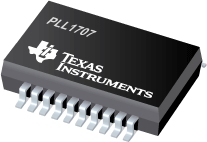

PLL1707是TI公司的一款无产品,PLL1707是3.3V 双路 PLL 多时钟发生器,本页介绍了PLL1707的产品说明、应用、特性等,并给出了与PLL1707相关的TI元器件型号供参考。
PLL1707 - 3.3V 双路 PLL 多时钟发生器 - 无 - 音频时钟 - TI公司(Texas Instruments,德州仪器)
The PLL1707 are low cost, phase-locked loop (PLL) multiclock generators. The PLL1707 and PLL1708 can generate four system clocks from a 27-MHz reference input frequency. The clock outputs of the PLL1707 can be controlled by sampling frequency-control pins and those of the PLL1708 can be controlled through serial-mode control pins. The device gives customers both cost and space savings by eliminating external components and enables customers to achieve the very low-jitter performance needed for high performance audio DACs and/or ADCs. The PLL1707 and PLL1708 are ideal for MPEG-2 applications which use a 27-MHz master clock such as DVD recorders, HDD recorders, DVD add-on cards for multimedia PCs, digital HDTV systems, and set-top boxes.
- 27-MHz Master Clock Input
- Generated Audio System Clock (PLL1707):
- SCKO0: 768 fS (fS = 44.1 kHz)
- SCKO1: 768 fS, 512 fS (fS = 48 kHz)
- SCKO2: 256 fS (fS = 32, 44.1, 48, 64, 88.2, 96 kHz)
- SCKO3: 384 fS (fS = 32, 44.1, 48, 64, 88.2, 96 kHz)
- Generated Audio System Clock (PLL1708):
- SCKO0: 768 fS (fS = 44.1 kHz)
- SCKO1: 768 fS, 512 fS, 384 fS , 256 fS (fS = 48 kHz)
- SCKO2: 256 fS (fS = 16, 22.05, 24, 32, 44.1, 48, 64, 88.2, 96 kHz)
- SCKO3: 384 fS (fS = 16, 22.05, 24, 32, 44.1, 48, 64, 88.2, 96 kHz)
- Zero PPM Error Output Clocks
- Low Clock Jitter: 50 ps (Typical)
- Multiple Sampling Frequencies (PLL1707):
- fS = 32, 44.1, 48, 64, 88.2, 96 kHz
- Multiple Sampling Frequencies (PLL1708):
- fS = 16, 22.05, 24, 32, 44.1, 48, 64, 88.2, 96 kHz
- 3.3-V Single Power Supply
- PLL1707: Parallel Control PLL1708: Serial Control
- Package: 20-Pin SSOP (150 mil), Lead-Free Product
- APPLICATIONS
- HDD + DVD Recorders
- DVD Recorders
- HDD Recorders
- DVD Players
- DVD Add-On Cards for Multimedia PCs
- Digital HDTV Systems
- Set-Top Boxes
The PLL1707 and PLL1708 use the same die and they are electrically identical except for mode control.







